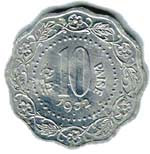Among Jawaharlal Nehru's many ambitions for India was to make its
measures metric, its thermometers Centigrade and its coinage decimal.
Easier said than done. Through the length and breadth of India, there
were more than 140 different systems of weights and measures. Dates and
records were kept according to 30 different calendars, at least one of
which, instituted more than 500 years ago with a slight miscalculation,
has slipped out of phase by 23.2 days, so that Hindu dances meant for
moonlit nights were often performed in total darkness. To top it all,
the Indian coinage system, based on the coinage standardized by
conquering British in 1835, was at least as unwieldy as that used in
Britain itself.
Having already established a national calendar of twelve months (more or less comparable to the Gregorian) and threatening soon to put weights and measures on the metric system, Nehru's government chose to inaugurate a new decimal coinage. In place of the rupee (20¢), anna (1/16 rupee) and pie (1/12 anna) of the past, the new money consist solely of rupees and naye paise (literally: new coins) worth .01 rupees. The trouble was that for three years both sets of coins was to be used at once, and since there wass not always a way of translating pies or annas into a precise number of naye paise, the government has had to decree a system of what parimutuel bettors call "breakage." i.e., the rounding off of small fractions that don't count too
As the first of 610.000,000 new coins poured into the bazaars, India's newspapers carried conversion tables with instructions on how to use them. Sample: "To make a payment of 36 naye paise, you first pay 4 annas or 25 naye paise, then pay the balance of 11 naye paise by tendering 1 anna and 9 pies."
In Calcutta, where thrifty Bengalis ran wild in 1953 over a ⅓cent rise in streetcar fares, mobs rioted around the post offices when it was discovered that the price of stamps would be rounded off in favor of the government. In industrial Kanpur, bus service was tied up for hours when bus drivers discovered they could not drive and argue about fares at the same time. Mothers fretted that the new coins were too easy for kids to swallow.
INDIA COINS BEFORE CONVERSION TO METRIC SYSTEM 1957

INDIAN COINS AFTER CONVERSION TO METRIC SYSTEM 1957

INDIAN COINS AFTER 1964

BRITISH RUPEES-COINS BEFORE 1947 -WHEN INDIA BECAME FREE NATION


Having already established a national calendar of twelve months (more or less comparable to the Gregorian) and threatening soon to put weights and measures on the metric system, Nehru's government chose to inaugurate a new decimal coinage. In place of the rupee (20¢), anna (1/16 rupee) and pie (1/12 anna) of the past, the new money consist solely of rupees and naye paise (literally: new coins) worth .01 rupees. The trouble was that for three years both sets of coins was to be used at once, and since there wass not always a way of translating pies or annas into a precise number of naye paise, the government has had to decree a system of what parimutuel bettors call "breakage." i.e., the rounding off of small fractions that don't count too
As the first of 610.000,000 new coins poured into the bazaars, India's newspapers carried conversion tables with instructions on how to use them. Sample: "To make a payment of 36 naye paise, you first pay 4 annas or 25 naye paise, then pay the balance of 11 naye paise by tendering 1 anna and 9 pies."
In Calcutta, where thrifty Bengalis ran wild in 1953 over a ⅓cent rise in streetcar fares, mobs rioted around the post offices when it was discovered that the price of stamps would be rounded off in favor of the government. In industrial Kanpur, bus service was tied up for hours when bus drivers discovered they could not drive and argue about fares at the same time. Mothers fretted that the new coins were too easy for kids to swallow.
INDIA COINS BEFORE CONVERSION TO METRIC SYSTEM 1957

INDIAN COINS AFTER CONVERSION TO METRIC SYSTEM 1957

INDIAN COINS AFTER 1964

BRITISH RUPEES-COINS BEFORE 1947 -WHEN INDIA BECAME FREE NATION
RUPEE -BRITISH INDIA -1940
One
British Rupee was 28 and a half chakkaram and one sarkar ( Travancore
Government) rupai was 28 chakarams. One chakaram was 16 kasu.
ONE British rupee was made up of 16annas and
one anna was equal to 12 pices:-.
BRITISH 1/4 Anna, 1/2 Pice :- BELOW





















